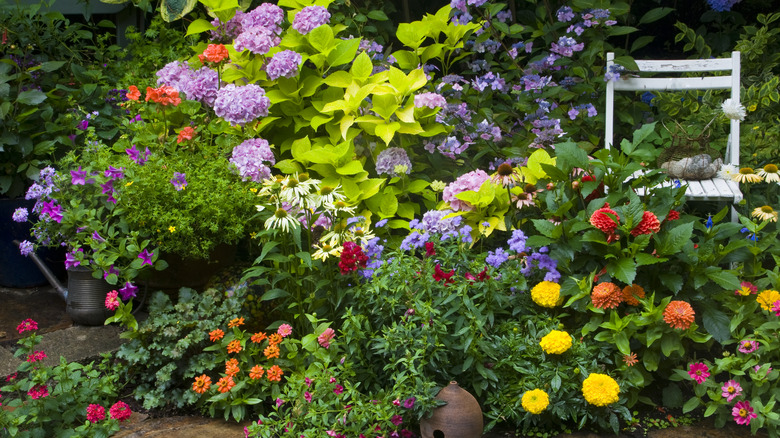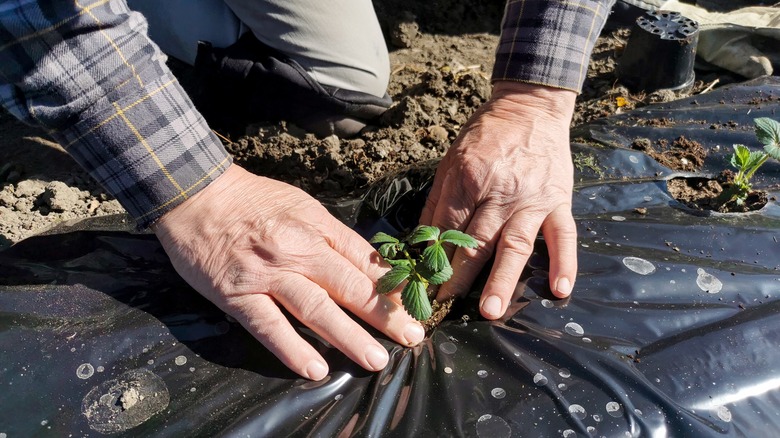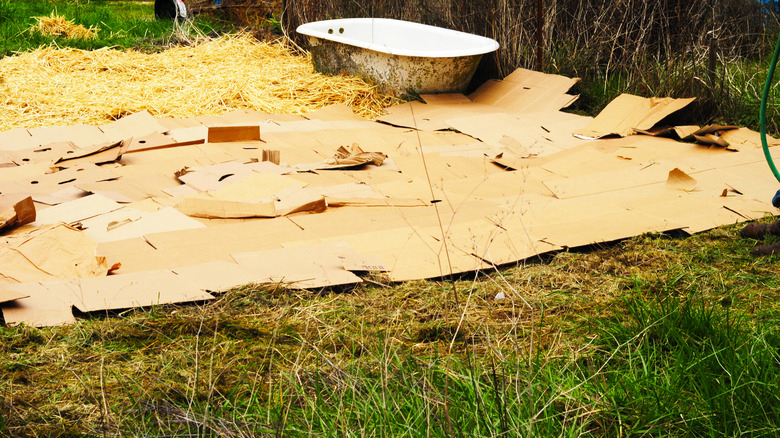How To Smother Weeds Effectively For A Beautiful Flower Garden
Whether your existing flower garden has been ravaged by weeds or you've decided to create a new garden in a particularly weedy plot, one method is sure to get rid of stubborn and thriving weeds: smothering. While this technique sounds rather violent, you'll be saving yourself the time, energy, and back pain that comes along with pulling, tilling, and hoeing weeds in your flower beds — all of which disturb the soil and make it the ideal place for unwanted plant seeds to germinate and overtake your garden once more. You can effectively smother weeds in your garden using a black plastic sheet or organic mulch for a consistent flower garden that blooms without obstruction.
A method of weed control similar to — and sometimes synonymous with — mulching, smothering is ideal for keeping unwanted plants from photosynthesizing to prepare your garden beds with minimal cost and effort. Again, thwarting its murderous namesake, smothering weeds with organic or inorganic coverings won't introduce harmful herbicides or any other toxins into your garden. In fact, some of them can provide more nutrients as plant materials break down. It's wise to manage your expectations, however, as smothering can take multiple tries before all the weed seeds have been eliminated.
Smothering weeds with a black plastic sheet
If your flower garden is covered in weeds or unruly grass, a black plastic sheet could be the answer to getting rid of these invaders while increasing the health of your soil and ensuring tons of weed seedlings won't pop up again in the following weeks. Among the least harmful ways to kill weeds in your lawn, occultation works by cooking the vegetation and seeds. Below the tarp is a dark, hot, and humid environment where seeds germinate but can't survive into adulthood. Remember that you can use almost any old opaque covering for occultation. Ideally, the sheet should be made of UV-stabilized plastic, but anything that can be weighed down to limit airflow, lock heat in, and keep water off the soil will work. The practice is effective when used correctly, but it may take up to a full season before all the weeds are killed, which makes it quite time-consuming.
Depending on your garden's design and progress, you can lay a black sheet across the entire plot for a fresh start or take extra steps to cut holes in the plastic to accommodate the flowers you want to keep growing this season. Before rolling out your weed-smothering blanket, take the time to trim and till the bed to speed up germination and decomposition. After about a month, anything previously growing beneath the tarp should have decayed, leaving you with rich, damp soil ready for planting flowers.
Smothering weeds with cardboard and yard waste
Mulching with opaque tarps is a low-maintenance and non-toxic way to rid your flower beds of weeds, but it's also time-consuming and not very eco-friendly. You'll need to remove the plastic sheeting — intact tarps can be rinsed and stored for later, but ones with holes or tears may need to be tossed or repurposed, like with this hack that'll save you from shoveling your snowy driveway. If this method doesn't speak to you, consider smothering weeds with cardboard and a layer of organic mulch instead.
Compared to black plastic, this natural option, known as sheet mulching, has the disadvantage of being semi-permanent, staying in the garden and breaking down over time. However, it's also much more attractive to look at, offers nutrients to the soil below, and keeps it cool. Layer your cardboard or newspaper onto the soil and cover it with a few inches of lawn clippings, wood chips, and leftover food scraps. Like with occultation, trim down weeds before applying cardboard or pull as many as possible. Organic mulch packed too thickly on top of the soil is among the most common mulching mistakes, creating problems with pests and rotting, so be sure you don't pile it on too high. With the proper technique, you'll smother the weeds beneath the surface, blocking their access to sunlight and oxygen and creating nutritious soil for your next crop of flowers.


